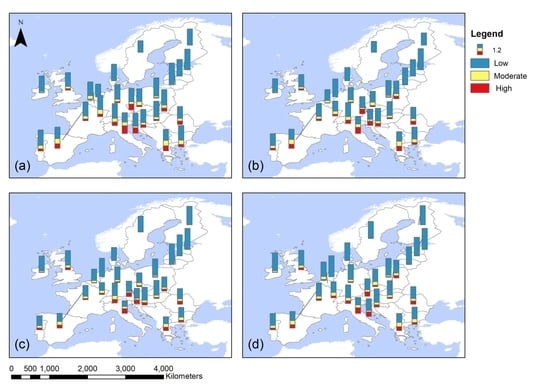A European-Scale Investigation of Soil Erosion Threat to Subsurface Archaeological Remains
Abstract
1. Introduction
2. Materials and Methods
2.1. Data Related to the Preservation Capacity of European Soils
2.2. Data Related to Soil Loss by Water in Europe
2.3. Methodology
3. Results
4. Discussion
- Remark 1: Most of the European countries are considered low threat areas for all types of subsurface materials;
- Remark 2: Northern countries (e.g., Scandinavian) are almost exclusively considered low threat areas in contrast to Mediterranean countries, which are characterised with moderate and high risk. As a Mediterranean example, in Italy, the mean soil loss by water per year equals that of areas characterised as low or high risk for bone materials. This indicates that subsurface material in this country is widely exposed and threaten by soil loss in comparison to other countries;
- Remark 3: Areas characterised as low threat from soil erosion present approximately 10% of good preservation capacity, which varies depending on the type of the material.
- Remark 4: Similar patterns on a European scale for all types of materials are reported for areas characterised with moderate and high risk from soil loss.
5. Conclusions
Author Contributions
Funding
Acknowledgments
Conflicts of Interest
Appendix A
| Subsurface Archaeological Evidence | Metals | Bones | Organics | Stratigraphy | |||||||||
|---|---|---|---|---|---|---|---|---|---|---|---|---|---|
| Level of soil-loss threat (L: low; M: moderate; and H: high) | |||||||||||||
| Country | CODE | L | M | H | L | M | H | L | M | H | L | M | H |
| Netherlands | NL | 1.2 | 0.0 | 0.0 | 1.7 | 0.0 | 0.0 | 1.7 | 0.0 | 0.0 | 2.4 | 0.0 | 0.0 |
| Poland | PL | 1.6 | 0.1 | 0.1 | 1.4 | 0.1 | 0.1 | 1.5 | 0.1 | 0.0 | 1.9 | 0.2 | 0.1 |
| Portugal | PT | 1.4 | 0.3 | 0.2 | 1.1 | 0.3 | 0.2 | 0.9 | 0.2 | 0.2 | 1.4 | 0.3 | 0.2 |
| Romania | RO | 1.1 | 0.2 | 0.3 | 1.1 | 0.2 | 0.3 | 0.9 | 0.2 | 0.3 | 1.4 | 0.3 | 0.4 |
| Austria | AT | 1.2 | 0.2 | 0.5 | 0.9 | 0.2 | 0.4 | 0.9 | 0.2 | 0.4 | 1.3 | 0.2 | 0.5 |
| Belgium | BE | 1.3 | 0.3 | 0.1 | 1.0 | 0.2 | 0.0 | 1.0 | 0.2 | 0.0 | 1.7 | 0.3 | 0.1 |
| Bulgaria | BG | 1.3 | 0.4 | 0.2 | 1.1 | 0.3 | 0.2 | 0.9 | 0.3 | 0.2 | 1.4 | 0.4 | 0.2 |
| Czech Republic | CZ | 1.2 | 0.3 | 0.1 | 1.0 | 0.3 | 0.1 | 0.9 | 0.3 | 0.1 | 1.4 | 0.4 | 0.2 |
| Germany | DE | 1.3 | 0.2 | 0.1 | 1.1 | 0.2 | 0.1 | 1.2 | 0.2 | 0.1 | 1.7 | 0.2 | 0.1 |
| Denmark | DK | 1.5 | 0.0 | 0.0 | 1.2 | 0.0 | 0.0 | 1.2 | 0.0 | 0.0 | 2.0 | 0.0 | 0.0 |
| Estonia | EE | 1.9 | 0.0 | 0.0 | 1.9 | 0.0 | 0.0 | 1.9 | 0.0 | 0.0 | 2.4 | 0.0 | 0.0 |
| Greece | EL | 1.0 | 0.5 | 0.5 | 0.9 | 0.4 | 0.4 | 0.6 | 0.3 | 0.3 | 1.0 | 0.5 | 0.5 |
| Spain | ES | 1.1 | 0.5 | 0.4 | 0.9 | 0.4 | 0.4 | 0.7 | 0.3 | 0.3 | 1.1 | 0.5 | 0.4 |
| Finland | FI | 1.5 | 0.0 | 0.0 | 1.1 | 0.0 | 0.0 | 1.7 | 0.0 | 0.0 | 2.2 | 0.0 | 0.0 |
| France | FR | 1.3 | 0.3 | 0.2 | 1.2 | 0.2 | 0.2 | 1.0 | 0.2 | 0.1 | 1.6 | 0.3 | 0.2 |
| Croatia | HR | 1.2 | 0.2 | 0.2 | 1.2 | 0.2 | 0.3 | 1.2 | 0.2 | 0.2 | 1.6 | 0.3 | 0.3 |
| Hungary | HU | 1.4 | 0.2 | 0.1 | 1.3 | 0.2 | 0.1 | 1.4 | 0.2 | 0.1 | 1.7 | 0.2 | 0.2 |
| Ireland | IE | 1.4 | 0.1 | 0.0 | 1.2 | 0.1 | 0.0 | 1.4 | 0.1 | 0.0 | 2.1 | 0.2 | 0.0 |
| Italy | IT | 0.8 | 0.3 | 0.7 | 0.7 | 0.3 | 0.6 | 0.5 | 0.2 | 0.4 | 0.9 | 0.3 | 0.7 |
| Liechtenstein | LI | 1.3 | 0.3 | 0.3 | 1.3 | 0.3 | 0.3 | 1.2 | 0.3 | 0.3 | 1.5 | 0.3 | 0.3 |
| Lithuania | LT | 1.9 | 0.1 | 0.0 | 1.5 | 0.1 | 0.0 | 1.8 | 0.1 | 0.0 | 2.0 | 0.1 | 0.0 |
| Luxembourg | LU | 1.3 | 0.4 | 0.2 | 0.9 | 0.3 | 0.2 | 0.7 | 0.2 | 0.1 | 1.2 | 0.4 | 0.2 |
| Latvia | LV | 1.5 | 0.0 | 0.0 | 1.5 | 0.0 | 0.0 | 1.9 | 0.0 | 0.0 | 2.1 | 0.0 | 0.0 |
| Sweden | SE | 1.0 | 0.0 | 0.0 | 1.0 | 0.0 | 0.0 | 1.4 | 0.0 | 0.0 | 1.9 | 0.0 | 0.0 |
| Slovenia | SI | 1.2 | 0.1 | 0.5 | 1.0 | 0.1 | 0.4 | 0.9 | 0.1 | 0.4 | 1.3 | 0.2 | 0.5 |
| Slovakia | SK | 1.4 | 0.3 | 0.3 | 1.2 | 0.2 | 0.2 | 0.9 | 0.2 | 0.2 | 1.5 | 0.3 | 0.3 |
| United Kingdom | UK | 1.3 | 0.2 | 0.1 | 1.1 | 0.2 | 0.1 | 1.3 | 0.2 | 0.2 | 1.7 | 0.3 | 0.2 |
| Status of Preservation: 1: poor; 2: fair; and 3: good | |||||||||||||
Appendix B
References
- Joint Research Centre European Soil Data Centre (ESDAC). Erosion by Water. Available online: https://esdac.jrc.ec.europa.eu/themes/erosion (accessed on 1 February 2020).
- Pena, B.S.; Abreu, M.M.; Magalhães, R.M.; Cortez, N. Water erosion aspects of land degradation neutrality to landscape planning tools at national scale. Geoderma 2020, 363, 114093. [Google Scholar] [CrossRef]
- Borji, M.; Samani, N.A.; Rashidi, S.; Tiefenbacher, P.J. Catchment-scale soil conservation: Using climate, vegetation, and topo-Hydrological parameters to support decision making and implementation. Sci. Total Environ. 2020, 712, 136124. [Google Scholar] [CrossRef]
- Chandramohan, T.; Venkatesh, B.; Balchand, A.N. Evaluation of Three Soil Erosion Models for Small Watersheds. Aquat. Procedia 2015, 4, 1227–1234. [Google Scholar] [CrossRef]
- Bosco, C.; de Rigo, D.; Dewitte, O.; Poesen, J.; Panagos, P. Modelling soil erosion at European scale: Towards harmonization and reproducibility. Nat. Hazards Earth Syst. Sci. 2015, 15, 225–245. [Google Scholar] [CrossRef]
- Panagos, P.; Katsoyiannis, A. Soil erosion modelling: The new challenges as the result of policy developments in Europe. Environ. Res. 2019, 172, 470–474. [Google Scholar] [CrossRef] [PubMed]
- Liu, Y.-H.; Li, D.-H.; Chen, W.; Lin, B.-S.; Seeboonruang, U.; Tsai, F. Soil Erosion Modeling and Comparison Using Slope Units and Grid Cells in Shihmen Reservoir Watershed in Northern Taiwan. Water 2018, 10, 1387. [Google Scholar] [CrossRef]
- Alewell, C.; Borrelli, P.; Meusburger, K.; Panagos, P. Using the USLE: Chances, challenges and limitations of soil erosion modelling. Int. Soil Water Conserv. Res. 2019, 7, 203–225. [Google Scholar] [CrossRef]
- Borrelli, P.; Meusburger, K.; Ballabio, C.; Panagos, P.; Alewell, C. Object-Oriented soil erosion modelling: A possible paradigm shift from potential to actual risk assessments in agricultural environments. Land Degrad. Dev. 2018, 29, 1270–1281. [Google Scholar] [CrossRef]
- Quinton, J.N. Soil Erosion Modeling. In Encyclopedia of Agrophysics; Encyclopedia of Earth Sciences Series; Gliński, J., Horabik, J., Lipiec, J., Eds.; Springer: Berlin/Heidelberg, Germany, 2011. [Google Scholar]
- Avwunudiogba, A.; Hudson, F.P. A Review of Soil Erosion Models with Special Reference to the needs of Humid Tropical Mountainous Environments. Eur. J. Sustain. Dev. 2014, 3, 299–310. [Google Scholar] [CrossRef]
- Borrelli, P.; Robinson, D.A.; Fleischer, L.R. An assessment of the global impact of 21st century land use change on soil erosion. Nat. Commun. 2013, 8. [Google Scholar] [CrossRef]
- Renard, K.G.; Foster, G.R.; Weesies, G.A.; McCool, D.K.; Yoder, D.C. Predicting Soil Erosion by Water: A Guide to Conservation Planning with the Revised Universal Soil Loss Equation (RUSLE); US Department of Agriculture, Agricultural Research Service: Washington, DC, USA, 1997. [Google Scholar]
- Ghosal, K.; Das Bhattacharya, S. A Review of RUSLE Model. J. Indian Soc. Remote Sens. 2020. [Google Scholar] [CrossRef]
- Abdelwahab, O.M.M.; Ricci, G.F.; De Girolamo, A.M.; Gentile, F. Modelling soil erosion in a Mediterranean watershed: Comparison between SWAT and AnnAGNPS models. Environ. Res. 2018, 166, 363–376. [Google Scholar] [CrossRef]
- Panagos, P.; Van Liedekerke, M.; Jones, A.; Montanarella, L. European Soil Data Centre: Response to European policy support and public data requirements. Land Use Policy 2012, 29, 329–338. [Google Scholar] [CrossRef]
- Howland, M.D.; Jones, I.W.N.; Najjar, M.; Levy, E.T. Quantifying the effects of erosion on archaeological sites with low-Altitude aerial photography, structure from motion, and GIS: A case study from southern Jordan. J. Archaeol. Sci. 2018, 90, 62–70. [Google Scholar] [CrossRef]
- Ducke, B. An Integrative Approach to Archaeological Landscape Evaluation: Locational Preferences, Site Preservation and Uncertainty Mapping, the Archaeology of Erosion, the Erosion of Archaeology 2014. In Proceedings of the Brussels Conference, Brussels, Belgium, 28–30 April 2008; Meylemans, E., Poesen, J., Ven, I.I., Eds.; pp. 13–22. [Google Scholar]
- Huisman, H.; de Kort, J.-W.; Ketterer, M.E.; Reimann, T.; Schoorl, M.J.; van der Heiden, M.; van Soest, M.; van Egmond, F. Erosion of archaeological sites: Quantifying the threat using optically stimulated luminescence and fallout isotopes. Geoarchaeology 2019, 34, 478–494. [Google Scholar] [CrossRef]
- Davidson, A.D.; Grieve, C.I.; Tyler, N.A.; Barclay, J.G.; Maxwell, S.G. Archaeological Sites: Assessment of Erosion Risk. J. Archaeol. Sci. 1998, 25, 857–860. [Google Scholar] [CrossRef]
- Kushwaha, S.K.P.; Dayal, K.R.; Sachchidanand; Raghavendra, S.; Pande, H.; Tiwari, P.S.; Agrawal, S.; Srivastava, S.K. 3D Digital Documentation of a Cultural Heritage Site Using Terrestrial Laser Scanner—A Case Study. In Applications of Geomatics in Civil Engineering; Ghosh, J., da Silva, I., Eds.; Lecture Notes in Civil Engineering; Springer: Singapore, 2020; Volume 33. [Google Scholar]
- Stampouloglou, M.; Toska, O.; Tapinaki, S.; Kontogianni, G.; Skamantzari, M.; Georgopoulos, A. 3D Documentation and Virtual Archaeological Restoration of Macedonian tombs. Int. Arch. Photogramm. Remote Sens. Spat. Inf. Sci. 2019, 1073–1080. [Google Scholar] [CrossRef]
- Tapete, D.; Cigna, F. COSMO-SkyMed SAR for Detection and Monitoring of Archaeological and Cultural Heritage Sites. Remote Sens. 2019, 11, 1326. [Google Scholar] [CrossRef]
- Agapiou, A.; Lysandrou, V.; Sarris, A.; Papadopoulos, N.; Hadjimitsis, D.G. Fusion of Satellite Multispectral Images Based on Ground-Penetrating Radar (GPR) Data for the Investigation of Buried Concealed Archaeological Remains. Geosciences 2017, 7, 40. [Google Scholar] [CrossRef]
- Malfitana, D.; Leucc, G.; Fragalà, G.; Masini, N.; Scardozzi, G.; Cacciaguerra, G.; Santagati, C.; Sheh, E. The potential of integrated GPR survey and aerial photographic analysis of historic urban areas: A case study and digital reconstruction of a Late Roman villa in Durrës (Albania). J. Archaeol. Sci. Rep. 2015, 4, 276–284. [Google Scholar] [CrossRef]
- Sarris, A.; Papadopoulos, N.; Agapiou, A.; Salvi, M.C.; Hadjimitsis, D.G.; Parkinson, A.; Yerkes, R.W.; Gyucha, A.; Duffy, R.P. Integration of geophysical surveys, ground hyperspectral measurements, aerial and satellite imagery for archaeological prospection of prehistoric sites: The case study of Vésztő-Mágor Tell, Hungary. J. Archaeol. Sci. 2013, 40, 1454–1470. [Google Scholar] [CrossRef]
- Pavelka, K., Jr.; Hanuš, J.; Raeva, P.; Gojda, M. Using of both hyperspectral aerial sensing and RPAS multispectral sensing for potential archaeological sites detection. In Proceedings of the SPIE 10780, Multispectral, Hyperspectral, and Ultraspectral Remote Sensing Technology, Techniques and Applications VII, Honolulu, HI, USA, 23 October 2018. [Google Scholar] [CrossRef]
- Pavelka, K.; Šedina, J.; Matoušková, E. High Resolution Drone Surveying of the Pista Geoglyph in Palpa, Peru. Geosciences 2018, 8, 479. [Google Scholar] [CrossRef]
- Lasaponara, R.; Leucci, G.; Masini, N.; Persico, R.; Scardozzi, G. Towards an operative use of remote sensing for exploring the past using satellite data: The case study of Hierapolis (Turkey). Remote Sens. Environ. 2016, 174, 148–164. [Google Scholar] [CrossRef]
- Papadopoulos, G.N.; Sarris, A.; Salvi, M.C.; Dederix, S.; Soupios, P.; Dikmen, U. Rediscovering the small theatre and amphitheatre of ancient Ierapytna (SE Crete) by integrated geophysical methods. J. Archaeol. Sci. 2012, 39, 1960–1973. [Google Scholar] [CrossRef]
- Lysandrou, V.; Agapiou, A. Cities of the dead: Approaching the landscape of Hellenistic and Roman necropoleis of Cyprus. Archaeol. Anthropol. Sci. 2016, 8, 867–877. [Google Scholar] [CrossRef]
- Kibblewhite, M.; Tóth, G.; Hermann, T. Predicting the preservation of cultural artefacts and buried materials in soil. Sci. Total Environ. 2015, 529, 249–263. [Google Scholar] [CrossRef]
- Joint Research Centre European Soil Data Centre (ESDAC). European Soil Database v2.0 (Vector and Attribute Data). Available online: https://esdac.jrc.ec.europa.eu/content/european-soil-database-v20-vector-and-attribute-data (accessed on 1 February 2020).
- Joint Research Centre European Soil Data Centre (ESDAC). European Soil Database & Soil Properties. Available online: https://esdac.jrc.ec.europa.eu/resource-type/european-soil-database-soil-properties (accessed on 1 February 2020).
- Joint Research Centre European Soil Data Centre (ESDAC). Soil Erosion by Water (RUSLE2015). Available online: https://esdac.jrc.ec.europa.eu/content/soil-erosion-water-rusle2015 (accessed on 17 February 2020).
- Panagos, P.; Borrelli, P.; Poesen, J.; Ballabio, C.; Lugato, E.; Meusburger, K.; Montanarella, L.; Alewell, C. The new assessment of soil loss by water erosion in Europe. Environ. Sci. Policy 2015, 54, 438–447. [Google Scholar] [CrossRef]
- Maio, R.; Miguel Ferreira, T.; Vicente, R. A critical discussion on the earthquake risk mitigation of urban cultural heritage assets. Int. J. Disaster Risk Reduct. 2018, 27, 239–247. [Google Scholar] [CrossRef]
- Pan, Y.; Wang, X.; Guo, R.; Yuan, S. Seismic damage assessment of Nepalese cultural heritage building and seismic retrofit strategies: 25 April 2015 Gorkha (Nepal) earthquake. Eng. Fail. Anal. 2018, 87, 80–95. [Google Scholar] [CrossRef]
- Agapiou, A.; Lysandrou, V.; Themistocleous, K.; Hadjimitsis, D.G. Risk assessment of Cultural Heritage Sites Clusters Using Satellite Imagery and GIS: The case study of Paphos District, Cyprus. Nat. Hazards 2016, 83, 5–20. [Google Scholar] [CrossRef]
- Tapete, D.; Cigna, F. Trends and perspectives of space-Borne SAR remote sensing for archaeological landscape and cultural heritage applications. J. Archaeol. Sci. Rep. 2017, 14, 716–726. [Google Scholar] [CrossRef]
- Zhou, W.; Chen, F.; Guo, H. Differential Radar Interferometry for Structural and Ground Deformation Monitoring: A New Tool for the Conservation and Sustainability of Cultural Heritage Sites. Sustainability 2015, 7, 1712–1729. [Google Scholar] [CrossRef]
- Yuan, C.; He, Y.; Feng, Y.; Wang, P. Fire hazards in heritage villages: A case study on Dangjia Village in China. Int. J. Disaster Risk Reduct. 2018, 28, 748–757. [Google Scholar] [CrossRef]
- Agapiou, A.; Lysandrou, V.; Alexakis, D.D.; Themistocleous, K.; Cuca, B.; Sarris, A.; Argyrou, N.; Hadjimitsis, D.G. Cultural heritage management and monitoring using remote sensing data and GIS: The case study of Paphos area, Cyprus. CEUS Comput. Environ. Urban Syst. 2015, 54, 230–239. [Google Scholar] [CrossRef]
- Marrion, E.C. More effectively addressing fire/disaster challenges to protect our cultural heritage. J. Cult. Herit. 2016, 20, 746–749. [Google Scholar] [CrossRef]
- Cuca, B.; Agapiou, A. Impact of land use change and soil erosion on cultural landscapes: The case of cultural paths and sites in Paphos district, Cyprus. Appl. Geomat. 2018, 10, 515. [Google Scholar] [CrossRef]
- Pourkerman, M.; Marriner, N.; Morhange, C.; Djamali, M.; Amjadi, S.; Lahijani, H.; Beni, N.A.; Vacchi, M.; Tofighian, H.; Shah-Hoesseini, M. Tracking shoreline erosion of “at risk” coastal archaeology: The example of ancient Siraf (Iran, Persian Gulf). Appl. Geogr. 2018, 101, 45–55. [Google Scholar] [CrossRef]
- Cencetti, C.; Di Matteo, L.; Romeo, S. Analysis of Costantino Landslide Dam Evolution (Southern Italy) by Means of Satellite Images, Aerial Photos, and Climate Data. Geosciences 2017, 7, 30. [Google Scholar] [CrossRef]
- Canuti, P.; Casagli, N.; Catani, F.; Fanti, R. Hydrogeological hazard and risk in archaeological sites some case studies in Italy. J. Cult. Herit. 2000, 12, 117–125. [Google Scholar] [CrossRef]
- Kiruthiga, K.; Thirumaran, K. Effects of urbanization on historical heritage buildings in Kumbakonam, Tamilnadu, India. Front. Archit. Res. 2019, 8, 94–105. [Google Scholar] [CrossRef]
- Swensen, G.; Jerpåsen, B.G. Cultural heritage in suburban landscape planning A case study in Southern Norway. Landsc. Urban Plan. 2008, 874, 289–300. [Google Scholar] [CrossRef]
- Sesana, E.; Bertolin, C.; Gagnon, A.S.; Hughes, J.J. Mitigating Climate Change in the Cultural Built Heritage Sector. Climate 2019, 7, 90. [Google Scholar] [CrossRef]
- Hao, L.; Herrera-Avellanosa, D.; Del Pero, C.; Troi, A. Categorization of South Tyrolean Built Heritage with Consideration of the Impact of Climate. Climate 2019, 7, 139. [Google Scholar] [CrossRef]
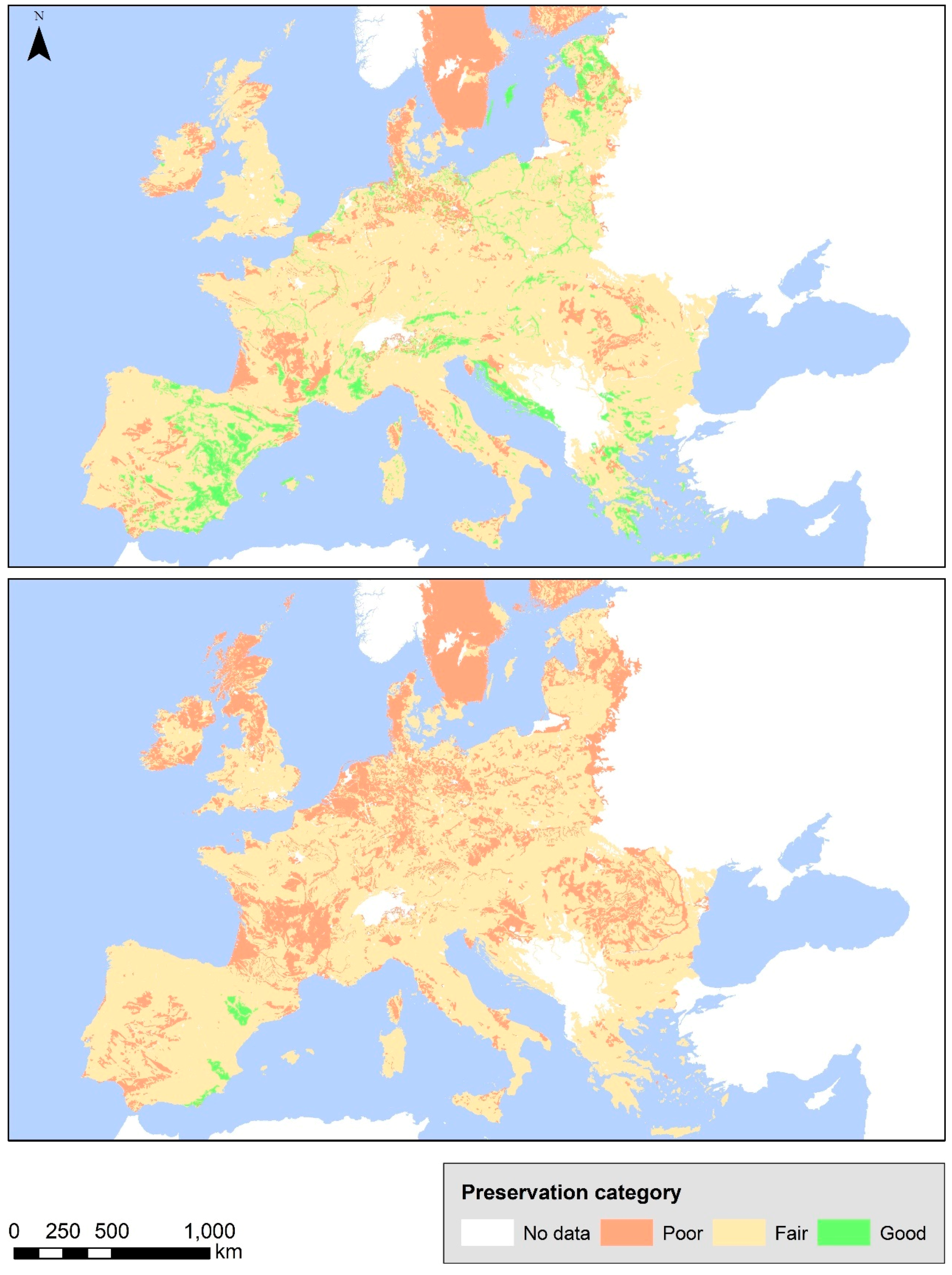






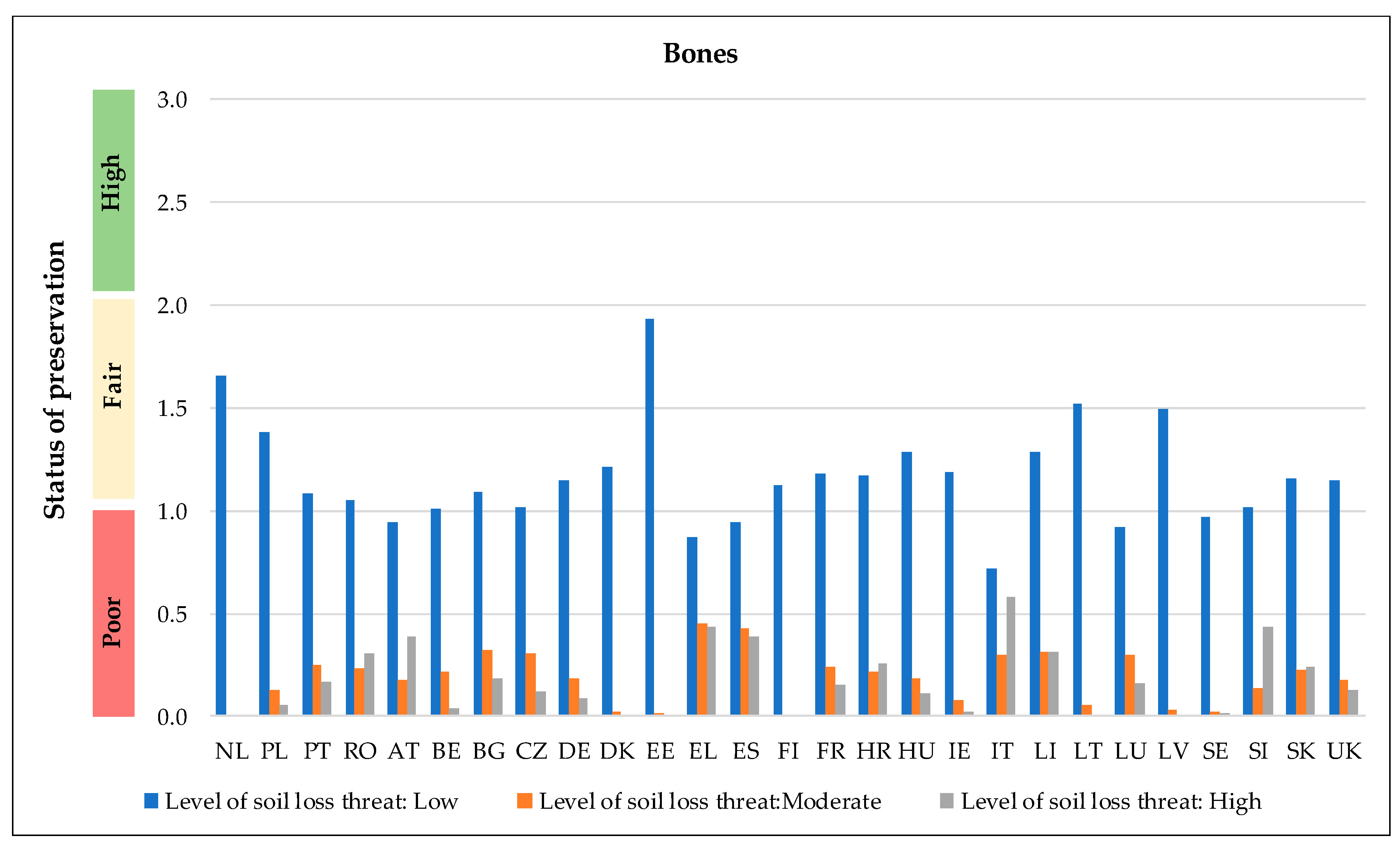
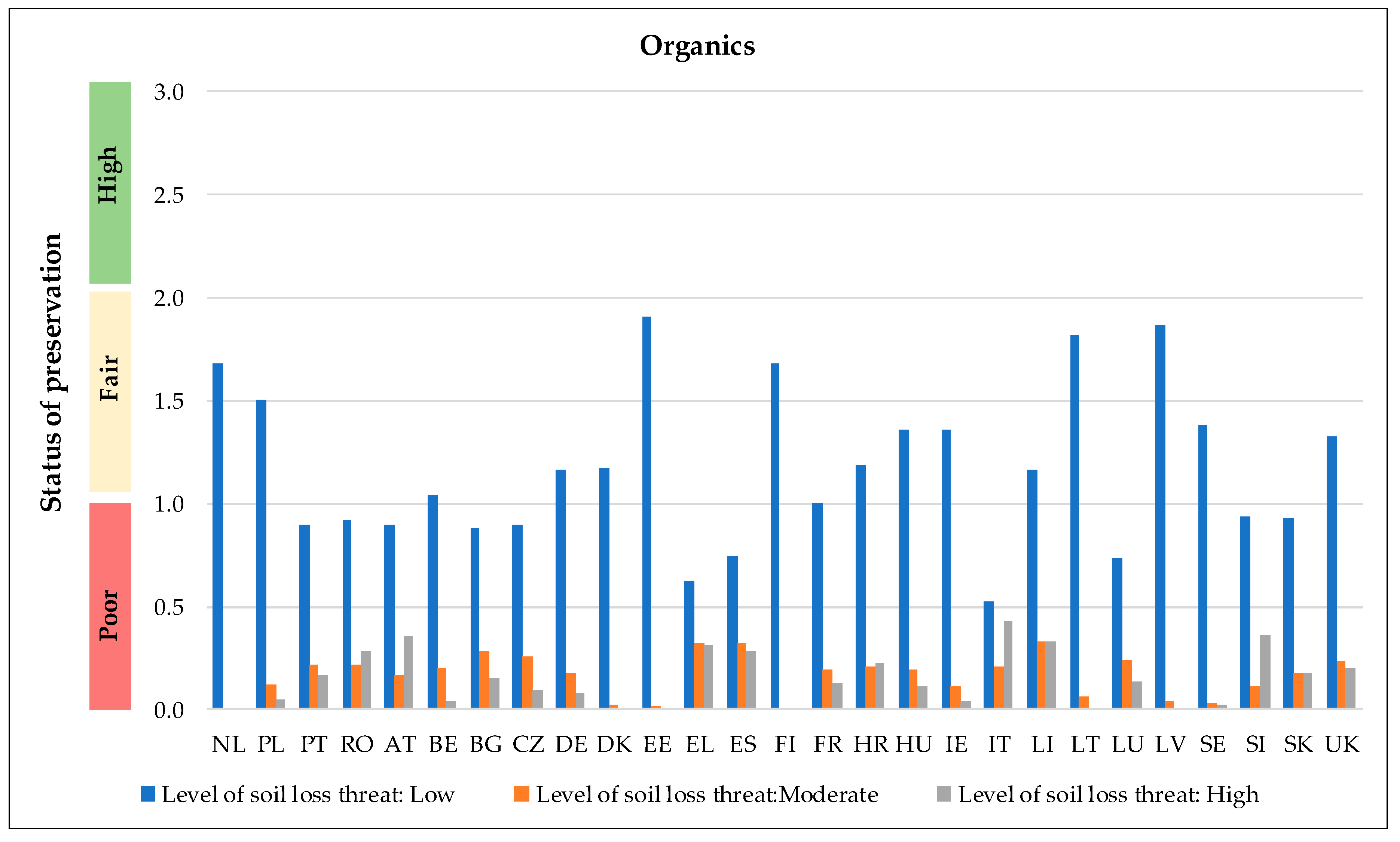



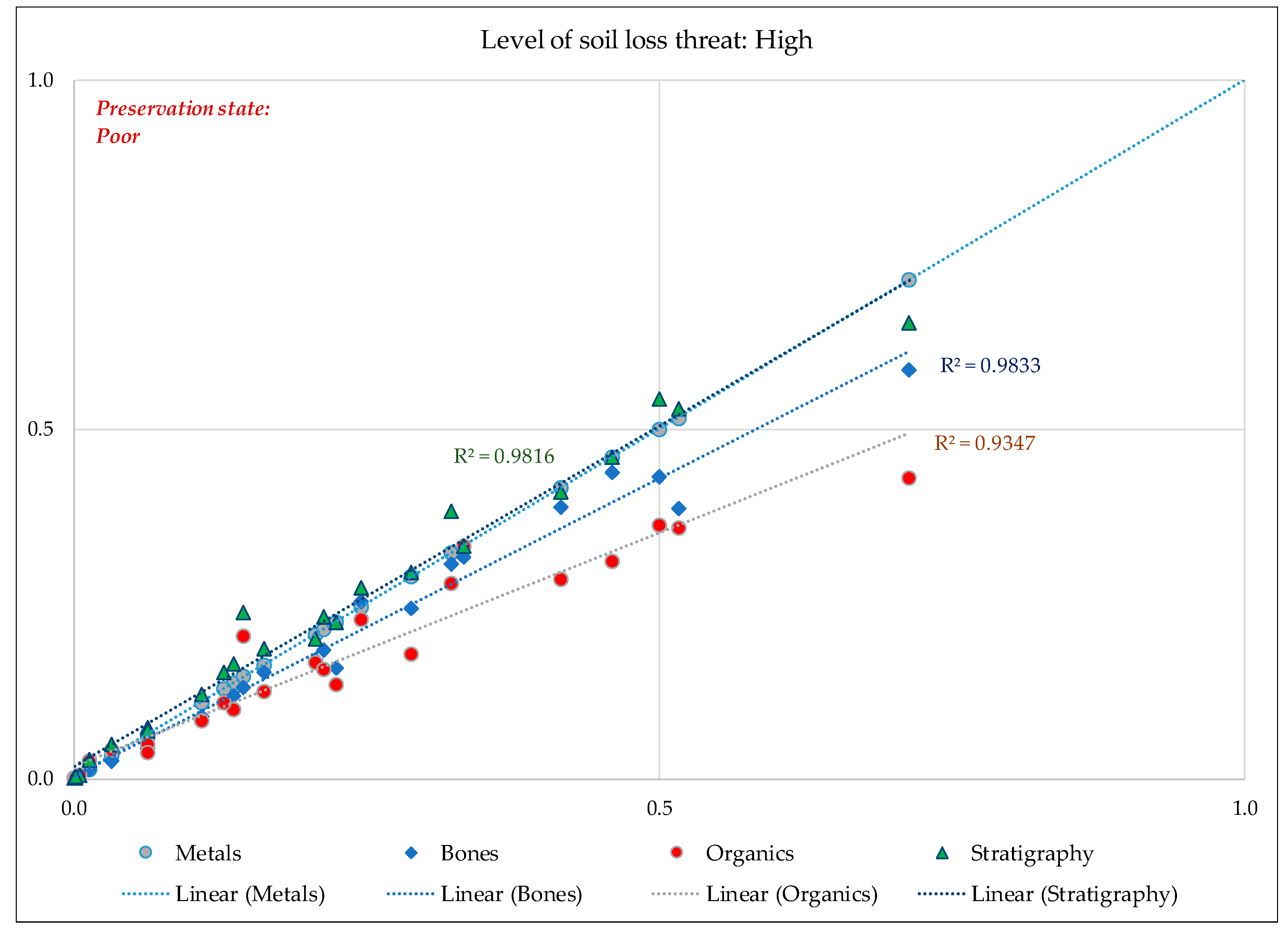
| Subsurface Evidence | Soil-Loss Threat | Area (square km) Preservation Status | ||
|---|---|---|---|---|
| Poor | Fair | Good | ||
| Metals | Low | 1,013,220 | 1,913,126 | 7212 |
| Moderate | 95,775 | 394,794 | 6304 | |
| High | 68,053 | 378,232 | 3652 | |
| Bones | Low | 2,401,458 | 527,333 | 5319 |
| Moderate | 375,144 | 121,650 | 128 | |
| High | 337,612 | 112,308 | 27 | |
| Organics | Low | 1,589,420 | 1,251,800 | 92,890 |
| Moderate | 317,705 | 167,038 | 12,179 | |
| High | 293,477 | 146,249 | 10,221 | |
| Stratigraphy | Low | 94,458 | 2,443,859 | 395,793 |
| Moderate | 33,563 | 423,471 | 39,888 | |
| High | 42,113 | 383,364 | 24,470 | |
© 2020 by the authors. Licensee MDPI, Basel, Switzerland. This article is an open access article distributed under the terms and conditions of the Creative Commons Attribution (CC BY) license (http://creativecommons.org/licenses/by/4.0/).
Share and Cite
Agapiou, A.; Lysandrou, V.; Hadjimitsis, D.G. A European-Scale Investigation of Soil Erosion Threat to Subsurface Archaeological Remains. Remote Sens. 2020, 12, 675. https://doi.org/10.3390/rs12040675
Agapiou A, Lysandrou V, Hadjimitsis DG. A European-Scale Investigation of Soil Erosion Threat to Subsurface Archaeological Remains. Remote Sensing. 2020; 12(4):675. https://doi.org/10.3390/rs12040675
Chicago/Turabian StyleAgapiou, Athos, Vasiliki Lysandrou, and Diofantos G. Hadjimitsis. 2020. "A European-Scale Investigation of Soil Erosion Threat to Subsurface Archaeological Remains" Remote Sensing 12, no. 4: 675. https://doi.org/10.3390/rs12040675
APA StyleAgapiou, A., Lysandrou, V., & Hadjimitsis, D. G. (2020). A European-Scale Investigation of Soil Erosion Threat to Subsurface Archaeological Remains. Remote Sensing, 12(4), 675. https://doi.org/10.3390/rs12040675






